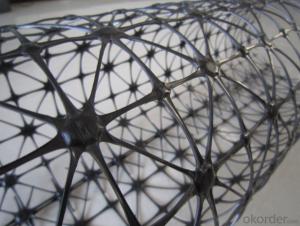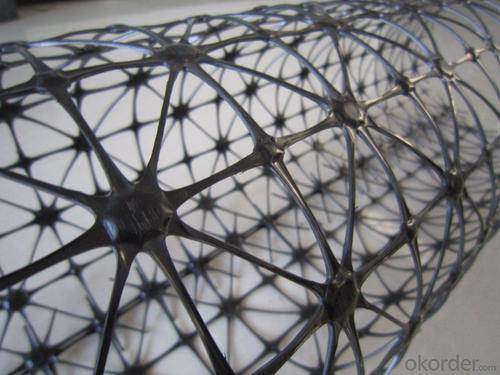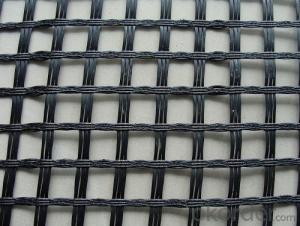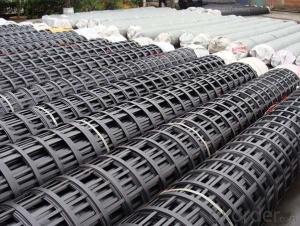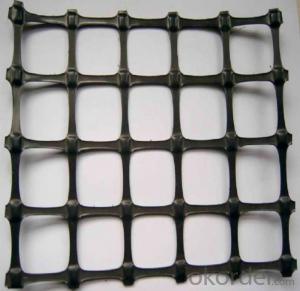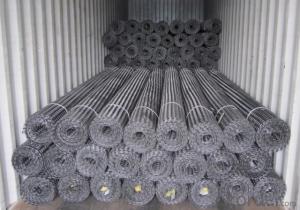PVC Coated Polyester/PP/Fiberglass Geogrids Noise Reduction
- Loading Port:
- China main port
- Payment Terms:
- TT OR LC
- Min Order Qty:
- 5000 m²
- Supply Capability:
- 1000000 m²/month
OKorder Service Pledge
OKorder Financial Service
You Might Also Like
Introduction of Fiberglass Geogrid:
Fiberglass geogrid is based on fiberglass woven cloth coated with modified bitumen or PVC, it was developed to address the problem of pavement cracking on highways, roads and runways, driven by a need to reduce cost for infrastructure maintenance and repair.
It is characterized by high tensile strength in axial and lateral directions, low stretch rate, alkali-resistance, low temperature- resistance, as well as convenience in construction and low price. It can be used on pitch pavement to prevent cracks and prolong pavement service life. It also can be used as a basal reinforcement material for hillsides, reservoirs, harbors, ports, water channels, seawalls, etc.
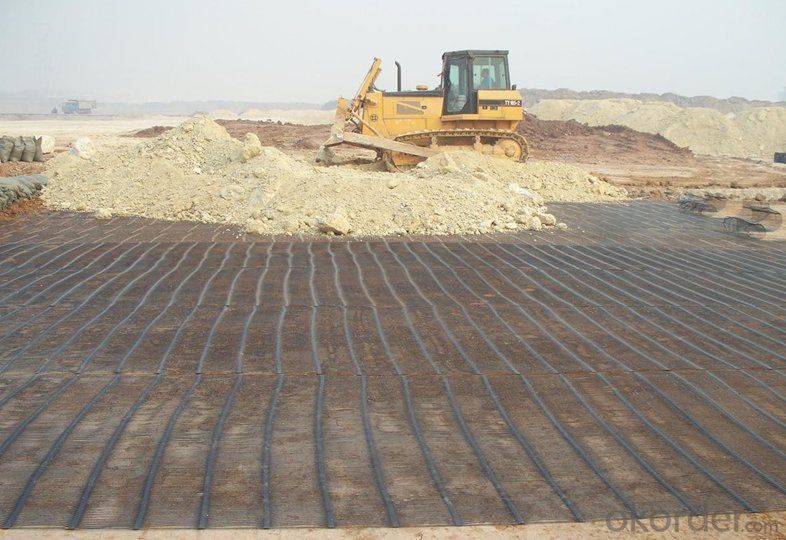

Features:
1.Intensity of vertically and horizontally from 20 KN/M to 150 KN/M
2.Low breaking elongation, not bigger than 3%
3.Suitable for each kind of soil environment
4.For treatment on surface, the rib suppresses the rough pattern, strengthens the grill surface the rough degree, enhances the GSZ steel plastic complex geogrid in the soil body friction factor.
5.It has more superior breadth, up to 2- 6 m, reducing construction joining, enhances the work efficiency.
6.High intensity, low creep and distorting
7.Resistant to erosion, longer life.
8.Easy and convenient to install, short period and low cost- saving. It can save project cost by 10%- 50%.
FAQ:
Q: Can you accept small trial order?
A: Yes, we accept small trial orders at reasonable charge.
Q:May I get one sample for checking out the quality? How much?
A: Yes, we supply sample free of charge, and the freight will be on buyer’s account, which is refundable when order confirmed.
Q: What is your MOQ?
A: Normally, 1000 m2 per order.
Q: What is your delivery time? Can we have it sooner?
A: 2 days for sample, 3-5 days against 1x40HQ
Q: What is your payment terms?
A: T/T, Paypal (3% surcharge), Western Union or 30% deposit 70% L/C.
- Q: How do geogrids improve the performance of unpaved trails?
- Geogrids improve the performance of unpaved trails by providing reinforcement to the soil, increasing its stability and load-bearing capacity. They prevent soil erosion and rutting by distributing the applied loads more evenly, reducing the likelihood of surface deformation. Additionally, geogrids enhance the drainage capabilities of the trail, allowing for better water infiltration and reducing the chances of water accumulation and subsequent damage.
- Q: The amount of geotextile is estimated to be used on both sides of the retaining wall
- The use of the depth is greater than geotextile, geogrid generally in the 1-2 m or deeper in the use of the scope of the geotextile in general about 50CM
- Q: Are geogrids suitable for use in reinforced soil slopes?
- Yes, geogrids are suitable for use in reinforced soil slopes. Geogrids provide stability and reinforcement to the soil, preventing erosion and slope failure. They enhance the strength and load-bearing capacity of the soil, making them an effective solution for reinforced soil slopes.
- Q: Are geogrids resistant to chemical attack from soil contaminants?
- Yes, geogrids are generally resistant to chemical attack from soil contaminants.
- Q: Can geogrids be used in reinforcement of coastal structures?
- Yes, geogrids can be used in the reinforcement of coastal structures. Geogrids are commonly used in coastal engineering to enhance the stability and strength of structures such as seawalls, revetments, and breakwaters. They provide additional reinforcement by improving soil cohesion and preventing erosion, thus increasing the durability and resilience of coastal structures against wave action and other environmental forces.
- Q: Are geogrids suitable for reinforcement of mechanically stabilized earth slopes?
- Yes, geogrids are suitable for the reinforcement of mechanically stabilized earth slopes. Geogrids provide effective reinforcement by distributing tensile forces and enhancing soil stability. They help to prevent slope failure, control erosion, and increase overall slope strength. Additionally, geogrids are easy to install and have a long lifespan, making them a reliable choice for reinforcement in mechanically stabilized earth slopes.
- Q: What is the difference between unidirectional geogrid and two-way geogrid
- The bidirectional grid is suitable for increasing the bearing capacity of the road (ground) base, and the service life of the Yan Changlu base. TwoThe utility model relates to a bidirectional grid which is suitable for preventing the collapse of the road surface and the generation of cracks. ThreeThe utility model has the advantages of convenient operation, time saving, labor saving, short construction period and reduced maintenance cost. FourThe utility model relates to a bidirectional grid which is suitable for preventing cracks in culvert. FiveTwo way grid is used to enhance soil slope and prevent soil erosion. Six
- Q: What is the meaning of 400g geotextiles /100g woven fabric
- Should be a layer of woven cloth PE film and a layer of geotextile. PE membrane and geotextile 400g
- Q: Do geogrids require any maintenance?
- Yes, geogrids typically do not require any maintenance once they are properly installed. They are designed to be durable and withstand the elements, so they generally do not need any regular upkeep or repairs.
- Q: Can geogrids be used in stabilization of coastal dunes?
- Yes, geogrids can be used in the stabilization of coastal dunes. Geogrids are commonly used in civil engineering applications to reinforce soils and provide stability. In the case of coastal dunes, geogrids can be installed to prevent erosion and maintain the shape of the dunes. The geogrids act as a reinforcement layer, distributing the load and restricting the movement of sand particles. This helps to stabilize the dunes and protect them from wind and water erosion.
Send your message to us
PVC Coated Polyester/PP/Fiberglass Geogrids Noise Reduction
- Loading Port:
- China main port
- Payment Terms:
- TT OR LC
- Min Order Qty:
- 5000 m²
- Supply Capability:
- 1000000 m²/month
OKorder Service Pledge
OKorder Financial Service
Similar products
Hot products
Hot Searches
Related keywords
